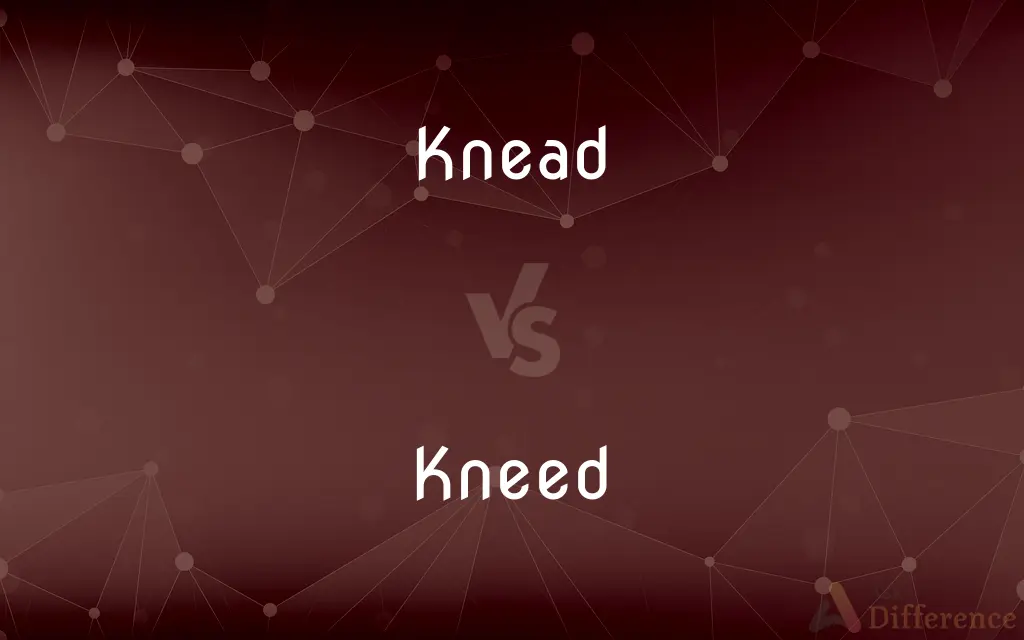Knead vs. Kneed — What's the Difference?
By Tayyaba Rehman & Urooj Arif — Updated on April 4, 2024
Kneading is a process of working dough to develop gluten, while kneed refers to striking or pressing with the knee.

Difference Between Knead and Kneed
Table of Contents
ADVERTISEMENT
Key Differences
Kneading is a culinary technique used in bread-making and pastry, involving pressing and stretching dough with the hands to develop gluten, which gives the dough elasticity and strength. This process is essential for the texture and structure of baked goods. On the other hand, kneed is the action of using one's knee to push or strike against something or someone. It is often used in the context of physical contact or as a part of a physical activity.
While kneading is a gentle, rhythmic action aimed at enhancing the dough's quality, kneed involves a more forceful, direct application of pressure or impact. Kneading is crucial in the preparation of various foods, helping to combine ingredients evenly and promote the development of a smooth, elastic dough. Conversely, kneed is typically mentioned in scenarios requiring physical exertion or in descriptions of physical altercations or accidents.
The skill of kneading can significantly affect the outcome of bread, pastries, and other baked goods, with the duration and technique of kneading altering the final product's texture. Kneed, however, is more about the application of force and has no role in food preparation or culinary arts.
In culinary contexts, the term "knead" is frequently encountered, reflecting the widespread importance of this technique in cooking and baking. Kneed, while less commonly used, is understood in various physical or metaphorical contexts involving the knees.
While kneading is an action that can be learned and perfected over time, becoming an integral part of baking routines, kneed is often spontaneous or instinctive, used in specific situations without the need for practice or refinement.
ADVERTISEMENT
Comparison Chart
Definition
The process of working dough to develop gluten.
To strike or press with the knee.
Context
Primarily used in baking and cooking.
Used in physical activities or as a descriptive action.
Purpose
To improve the texture and elasticity of dough.
To apply force or express a physical action with the knee.
Technique
Involves pressing, folding, and stretching dough.
Involves a direct action of hitting or pressing.
Result
Results in a smooth, elastic dough ready for baking.
Can result in physical impact or serve a specific function in an activity.
Compare with Definitions
Knead
Involves manual or mechanical action to prepare dough.
Using a stand mixer can also knead dough effectively.
Kneed
The action of pressing something forcefully with the knee.
He kneed the door open when his hands were full.
Knead
To work dough to develop its gluten structure.
She kneaded the bread dough until it was smooth and elastic.
Kneed
Involves the knee as a tool for physical impact.
Kneed in self-defense, she managed to escape the attacker.
Knead
A technique in baking to create the foundation for many types of bread.
Proper kneading is essential for a successful loaf.
Kneed
To hit or strike with the knee.
The soccer player kneed the ball into the net.
Knead
The action of mixing and working dough to ensure even distribution of ingredients.
Kneading for at least 10 minutes improves the bread's texture.
Kneed
Used metaphorically to describe a pressing or urgent action.
He kneed his way through the crowd.
Knead
The process of pushing and folding dough to activate gluten.
He learned to knead dough from his grandmother.
Kneed
Employed in martial arts as a technique.
The fighter kneed his opponent during the match.
Knead
To mix and work into a uniform mass, as by folding, pressing, and stretching with the hands
Kneading dough.
Kneed
The joint between the thigh and the lower leg, formed by the articulation of the femur and the tibia and covered anteriorly by the patella.
Knead
To make or shape by or as if by folding, pressing, and stretching with the hands.
Kneed
The region of the leg that encloses and supports this joint.
Knead
To squeeze, press, or roll with the hands, as in massaging
Kneading a painful calf muscle.
Kneed
An analogous joint or part of a leg of a quadruped vertebrate.
Knead
(transitive) To work and press into a mass, usually with the hands; especially, to work, as by repeated pressure with the knuckles, into a well mixed mass, the materials of bread, cake, etc.
Kneed
The joint between the femur and the tibia in an insect leg.
Knead
To treat or form as if by kneading; to beat.
Kneed
Something resembling the human knee, such as a bent piece of pipe.
Knead
Of cats, to make an alternating pressing motion with the two front paws.
Kneed
The part of a garment, as of trousers, that covers the knee.
Knead
(transitive) To mix thoroughly; form into a homogeneous compound.
Kneed
A vertical, often conical, woody projection arising from the roots of certain swamp-growing trees
Cypress knees.
Knead
The act of kneading something.
Kneed
To strike with the knee.
Knead
To work and press into a mass, usually with the hands; esp., to work, as by repeated pressure with the knuckles, into a well mixed mass, as the materials of bread, cake, etc.; as, to knead dough.
The kneading, the making of the cake, the heating of the oven, and the baking.
Kneed
Having a knee or knees, or, in combination, the stated type of knee or knees.
A kneed biped', ''a knobbly-kneed boy
Knead
Fig.: To treat or form as by kneading; to beat.
I will knead him : I'll make him supple.
Kneed
(botany) Having angular joints like the knee.
Knead
To press repeatedly with the hands or knuckles, sometimes with a twisting or squeezing motion; - performed for example on the body of a person as a form of massage.
Kneed
Simple past tense and past participle of knee
Knead
To perform movements like kneading, with the paws; - said of cats, which may knead{3} a master's body when stroked, presumably a sign of contentment; as, a cat kneading and purring in his master's lap.
Kneed
Having knees;- used chiefly in composition; as, in-kneed; out-kneed; weak-kneed.
Knead
Make uniform;
Knead dough
Work the clay until it is soft
Kneed
Geniculated; forming an obtuse angle at the joints, like the knee when a little bent; as, kneed grass.
Knead
Manually manipulate (someone's body), usually for medicinal or relaxation purposes;
She rubbed down her child with a sponge
Common Curiosities
What does it mean to knead dough?
Kneading dough involves working it with the hands to develop gluten, which improves the dough's elasticity and texture.
Are there alternatives to hand-kneading?
Alternatives to hand-kneading include using a dough mixer or adopting no-knead bread recipes that rely on long fermentation.
How is "kneed" used outside of physical actions?
"Kneed" can be used metaphorically to describe an action that involves pushing through or making one's way assertively.
What techniques are used in kneading?
Techniques include pressing, folding, and stretching the dough to evenly distribute ingredients and develop gluten.
Can kneading affect the outcome of bread?
Yes, the method and duration of kneading significantly influence the bread's texture, structure, and final quality.
What does "kneed" mean in a physical context?
In a physical context, to kneed means to strike or press with the knee, often used in sports or self-defense.
Is kneading a skill?
Yes, kneading is a skill that can be improved with practice, affecting the quality of baked goods.
Do kneading and kneed have any relation?
Beyond their phonetic similarity, kneading and kneed are unrelated, with one referring to a culinary technique and the other to a physical action.
Is kneading necessary for all types of dough?
While not all doughs require kneading, many, especially those for bread and pastries, do to develop the desired texture.
Can kneading be therapeutic?
Many find the rhythmic action of kneading dough by hand to be a calming and therapeutic activity.
Can machines knead dough?
Yes, machines like stand mixers with dough hooks can effectively knead dough, often used in both home and commercial baking.
What are common mistakes when kneading dough?
Common mistakes include under-kneading, over-kneading, adding too much flour, or not allowing the dough to rest.
Why might someone kneed another person?
Kneeding someone can be a deliberate action in martial arts, self-defense, or occasionally in competitive sports as an illegal move.
How long should dough be kneaded?
The kneading time can vary, typically ranging from 5 to 10 minutes by hand, depending on the recipe and desired dough texture.
What injuries can result from kneeding someone?
Kneeding can cause bruises, pain, or more serious injuries depending on the force and area impacted.
Share Your Discovery

Previous Comparison
Spelling vs. Pronunciation
Next Comparison
Drawal vs. DrawlAuthor Spotlight
Written by
Tayyaba RehmanTayyaba Rehman is a distinguished writer, currently serving as a primary contributor to askdifference.com. As a researcher in semantics and etymology, Tayyaba's passion for the complexity of languages and their distinctions has found a perfect home on the platform. Tayyaba delves into the intricacies of language, distinguishing between commonly confused words and phrases, thereby providing clarity for readers worldwide.
Co-written by
Urooj ArifUrooj is a skilled content writer at Ask Difference, known for her exceptional ability to simplify complex topics into engaging and informative content. With a passion for research and a flair for clear, concise writing, she consistently delivers articles that resonate with our diverse audience.
















































